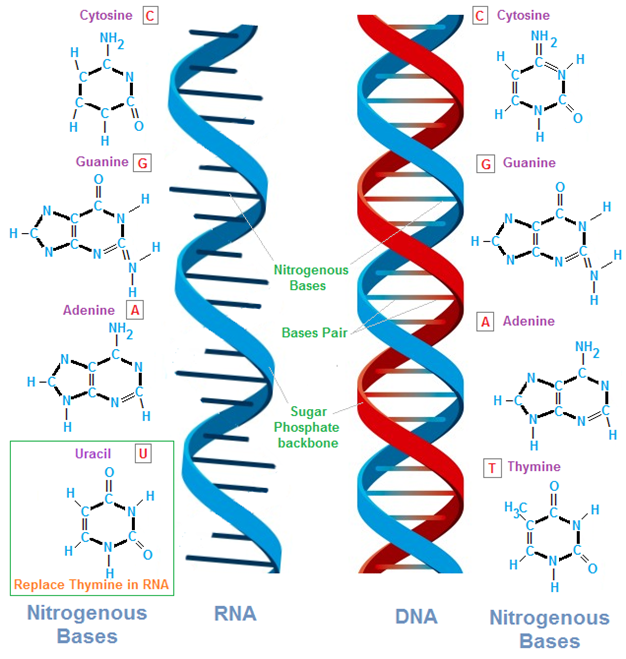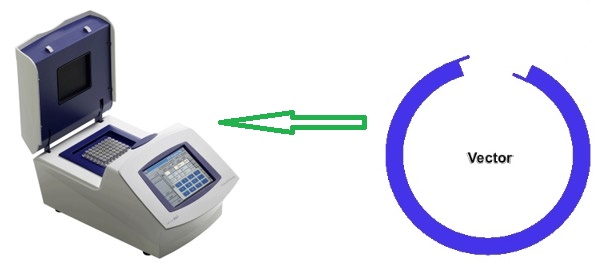An understanding of the nucleic acid molecules which include deoxyribonucleic acid (DNA) and ribonucleic acid (RNA) important for us to understand the molecular and/or genetic basis of life. Nucleic acid molecules are found in all living organisms as the carriers of genetic materials from parent organisms to their offspring’s. With the exception of viruses (which contain either a DNA or an RNA genome, and not both in one organism) all the other living organisms contain both DNA and RNA as their nucleic acid molecules.
These nucleic acid molecules are part of the essential macromolecules of life. Other macromolecules of life include proteins, carbohydrates and lipids. Ribonucleic acid (RNA) is a polymeric nucleic acid molecule that is made up of one or more nucleotides that contain the pentose sugar ribose. RNA is one of the two types of nucleic acid molecules found in all living cells.
The major biological function of the RNA in the cell is in the transmission of genetic information from DNA; and in the end the genetic information encoded in the DNA is translated into protein molecules – which are the major instruments through which the genetic potential of an organism are expressed. RNA unlike DNA is single stranded. RNA as a nucleic acid molecule performs several biological functions in every living organism. Most notably is the fact that RNA molecules helps in the expression of genes in a living organism.
Their order functions are in the coding, decoding, and regulation of gene expression in the cell of an organism. RNA molecules carry out the genetic information encoded in the DNA especially when protein synthesis is involved. RNA molecules can also act as enzymes in living organisms. Ribozymes are RNA molecules that function as catalysts and/or enzymes in living organisms, and they are found in both eukaryotic and prokaryotic cells – where they help to process RNA precursor molecules especially during protein synthesis. Ribozymes also known as catalytic RNA are found in the ribosomes where they help to join amino acids together to form protein chains.
According to the central dogma of molecular biology, the flow of genetic information in a living cell is from the DNA through the RNA and to proteins. In order words, the DNA makes RNA while the RNA makes the protein molecules. All the genetic materials required for the reproduction of new cells, tissues and/or the whole organism is contained in the DNA. RNA unlike DNA (that is double stranded) is single stranded structurally (Figure 1). DNA and RNA are in the form of strands of molecules that resembles a ladder.
A strand of DNA is composed of four nitrogenous bases known as adenine, guanine, thymine, and cytosine. RNA is different from DNA because it does not have thymine. RNA has uracil as a base in place of thymine. DNA and RNA are critical to all living things. DNA contains the genetic information that makes every living being what they are while RNA acts as a tool that enables cells to make the proper proteins (as encoded in the DNA). The overall structure of RNA and DNA consists of four nitrogenous bases that compose the backbone of their strands.
When the cell of an organism needs to synthesize a particular protein molecule, the protein’s gene (i.e. the portion of the DNA that codes for that particular protein to be synthesized) becomes activated. And once this is done, multiple copies of that piece of DNA in the form of messenger RNA (mRNA) will be immediately synthesized. These copies of mRNA so synthesized are then used to translate the genetic code (contained in the DNA molecule) into protein through the action of the cell’s protein manufacturing machinery. The protein manufacturing machinery of the cell is known as the ribosomes.

Protein molecules are usually made up of polypeptides, which are chains of amino acids linked together by peptide bonds; and protein synthesis in the cell is a multifaceted biological process in which the main constituents of the protein molecule (inclusive of the amino acids and protein structure) expressed in the cell is encoded and directed by the genetic information in the DNA. Proteins expressed in the cell are usually encoded by the genetic information in the DNA, but this varies for viruses whose nucleic acids are either DNA or RNA.
Thus, proteins can also be encoded in viral particles by the RNA. For protein synthesis to start, an RNA copy of the specific DNA molecule that encodes the particular protein to be biosynthesized must be synthesized first through the process of transcription. And it is this RNA copy that directs the synthesis of the protein in the cell (inclusive of eukaryotic and prokaryotic cells) through the process of translation. There are three major types of RNA molecules that participate in the protein-synthesizing pathway via which proteins are synthesized in the cell of an organism.
The three types of RNA molecule are:
- Messenger RNA (mRNA)
- Transfer RNA (tRNA)
- Ribosomal RNA (rRNA)
Messenger RNA (mRNA)
Messenger RNA (mRNA) carries the genetic information copied from the DNA in the form of a series of three-base code words known as codons; and each of these codons specifies a particular amino acid. Amino acids are the main building blocks of proteins. mRNA is the RNA that carries the actual genetic information for the synthesis of particular proteins from the DNA molecule.
Transfer RNA (tRNA)
Transfer (tRNA) carries amino acids to the ribosome of the cell where they are assembled into various protein molecules. They are the key to deciphering the code words in the mRNA molecules.
Ribosomal RNA (rRNA)
Ribosomal RNA (rRNA) is found in the ribosomes. They associate with certain proteins to form the ribosomes. rRNA basically serves as the structural components of protein-making structures known as ribosomes.
References
Alberts B, Bray D, Johnson A, Lewis J, Raff M, Roberts K andWalter P (1998). Essential Cell Biology: An Introduction to the Molecular Biology of the Cell. Third edition. Garland Publishing Inc., New York.
Ausubel, F.M., Brent, R., Kingston, R.E., Moore, D.D., Seidman, J.G., Smith, J.A., Struhl, K., eds (2002). Short Protocols in Molecular Biology, 5th edn. John Wiley & Sons, New York.
Bains W (1998). Biotechnology: From A to Z. 2nd ed. Oxford University Press, New York, USA.
Branden C and Tooze J (1998). Introduction to protein structure. A non-technical introduction to protein structure. New York: Garland Press.
Chen I and Dubnau D (2004). DNA uptake during bacterial transformation. Nat. Rev. Microbiol. 2 (3): 241–249.
Cooper G.M and Hausman R.E (2004). The cell: A Molecular Approach. Third edition. ASM Press.
Dale J (2003). Molecular genetics of bacteria. Jeremy W. Dale and Simon Park (4th eds.). John Wiley & Sons Ltd, West Sussex, UK. Pp. 312-313.
Dale J (2003). Molecular genetics of bacteria. Jeremy W. Dale and Simon Park (4th eds.). John Wiley & Sons Ltd, West Sussex, UK. Pp.
Glick B.R and Pasternak J.J (2003). Molecular Biotechnology: Principles and Applications of Recombinant DNA. ASM Press, Washington DC, USA.
Hames B.D and Rickwood D (1998). Gel Electrophoresis of Proteins: A Practical Approach 3rd Edition. The Practical Approach Series, Oxford University Press
Latha C.D.S and Rao D.B (2007). Microbial Biotechnology. First edition. Discovery Publishing House (DPH), Darya Ganj, New Delhi, India.
Lewis R (2007). Human Genetics: Concepts and Applications. Seventh edition. McGraw-Hill Companies, Inc, New York, USA.
Lodish H, Berk A, Matsudaira P, Kaiser C.A, Kreiger M, Scott M.P, Zipursky S.L and Darnell J (2004). Molecular Cell Biology. Fifth edition. Scientific American Books, Freeman, New York, USA.
Madigan M.T., Martinko J.M., Dunlap P.V and Clark D.P (2009). Brock Biology of Microorganisms, 12th edition. Pearson Benjamin Cummings Inc, USA.
Tamarin Robert H (2002). Principles of Genetics. Seventh edition. Tata McGraw-Hill Publishing Co Ltd, Delhi.
Thieman W.J, Palladamo M.A and Thieman W (2003). Introduction to Biotechnology. Benjamin Cummings, San Francisco, CA.
Discover more from #1 Microbiology Resource Hub
Subscribe to get the latest posts to your email.


